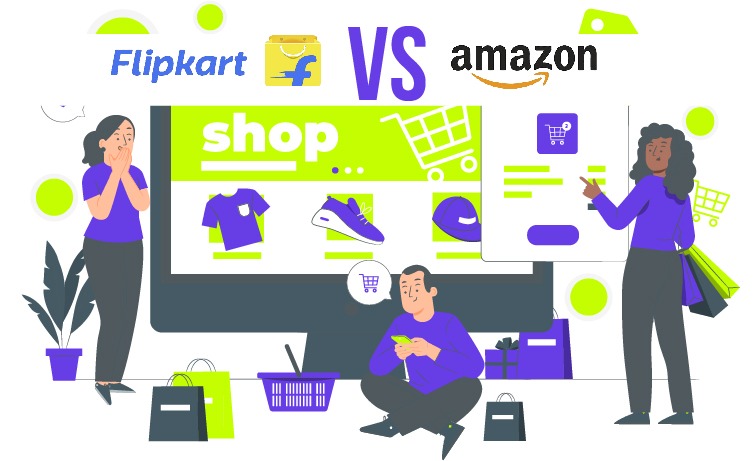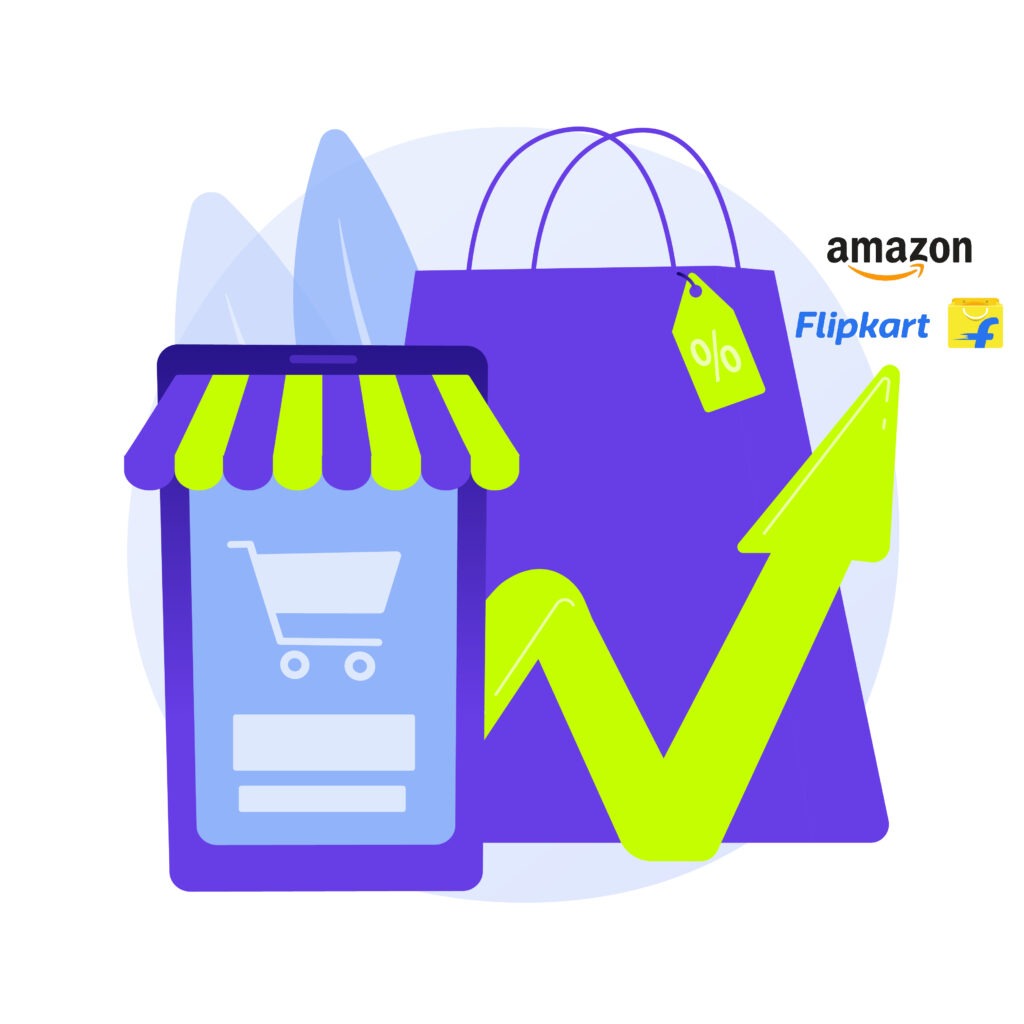How To Sell On Amazon and Flipkart

The e-commerce landscape has transformed dramatically over the past decade, with Amazon and Flipkart(walmart company) emerging as dominant players. Both platforms have leveraged innovative strategies to boost sales, tapping into the digital revolution and shifting consumer behaviors. This essay explores how e-commerce has increased sales on Amazon and Flipkart, emphasizing unique strategies, technological advancements, and customer-centric approaches. 1. Technological Innovations and Data Analytics One of the primary ways e-commerce platforms like Amazon and Flipkart increase sales is through the use of advanced technology and data analytics. Both the ecommerce giants utilize sophisticated algorithms to analyze vast amounts of data, including customer preferences, browsing behavior, and purchase history. This data-driven approach allows for personalized recommendations, which significantly enhance the customer shopping experience. Personalized Recommendations: Amazon’s recommendation engine is a critical driver of its sales growth. By analyzing past purchases and browsing history, Amazon suggests products that customers are likely to buy, thereby increasing the average order value. Similarly, Flipkart uses machine learning algorithms to recommend products, making the shopping experience more personalized and relevant for customers. Dynamic Pricing: Both Amazon and Flipkart employ dynamic pricing strategies, where the prices of products fluctuate based on demand, competition, and other market factors. This ensures that the prices remain competitive, attracting more customers and boosting sales. And examples of amazon and flipkart sales are shown below, Amazon Lightning Deals: Example: During major sales events like Amazon Prime Day or Black Friday, Amazon offers limited-time Lightning Deals on popular products. The prices of these products are significantly reduced for a short period, encouraging quick purchases. For instance, a smart TV that normally costs $499 might be available for $399 for a few hours. Competitive Price Matching: Example: Amazon constantly monitors prices on competitor websites and adjusts its prices accordingly. If a competitor like Walmart or Best Buy lowers the price of a specific laptop model, Amazon’s algorithm might quickly reduce its price to match or beat the competitor’s price. Big Billion Days Sale: Example: During Flipkart’s Big Billion Days Sale, products across various categories are offered at significantly reduced prices. For instance, a washing machine that usually costs ₹25,000 might be available for ₹18,000 during the sale period. Real-Time Price Adjustments: Example: Flipkart adjusts prices in real-time based on customer behavior and competitor pricing. If a particular model of a smartphone starts trending and selling rapidly, Flipkart might increase its price slightly to maximize profits while demand is high. 2. Expansive Product Range and Third-Party Sellers Another significant factor contributing to the sales growth of Amazon and Flipkart is their extensive product range. Both platforms offer a wide variety of products across multiple categories, catering to diverse customer needs. Marketplace Model: Amazon and Flipkart operate on a marketplace model, allowing third-party sellers to list their products. This model not only expands the range of products available but also fosters competition among sellers, leading to better prices and more options for consumers. The inclusion of third-party sellers also helps these platforms scale rapidly without bearing the inventory costs. Exclusive Partnerships and Private Labels: Both companies have entered into exclusive partnerships with brands and launched their private label products. These strategies ensure that customers have access to unique products that are not available on competing platforms. For instance, AmazonBasics offers a range of affordable and high-quality products, while Flipkart’s MarQ brand caters to the electronics and home appliances segment. 3. Enhanced Customer Experience Providing a superior customer experience is paramount for increasing sales in the e-commerce industry. Amazon and Flipkart invest heavily in various aspects of the customer journey to ensure a seamless shopping experience. User-Friendly Interface: Both platforms have intuitive and user-friendly interfaces that make it easy for customers to browse and purchase products. Features such as easy navigation, advanced search filters, and one-click purchasing contribute to a smooth shopping experience. Efficient Delivery and Logistics: Amazon and Flipkart have revolutionized delivery logistics with their extensive distribution networks and partnerships with local delivery services. Amazon Prime’s promise of fast and reliable delivery has set new standards in the industry, encouraging more customers to subscribe and shop frequently. Flipkart’s Ekart logistics ensures timely delivery, even in remote areas, enhancing customer satisfaction and loyalty. Customer Support: Effective customer support is crucial for maintaining customer trust and satisfaction. Both Amazon and Flipkart offer robust customer service through multiple channels, including phone, email, and chat support. Their hassle-free return and refund policies further instill confidence in customers, making them more likely to make repeat purchases. 4. Marketing and Promotional Strategies Aggressive marketing and promotional strategies play a vital role in driving sales on Amazon and Flipkart. These platforms utilize a mix of traditional and digital marketing techniques to attract and retain customers. Festive Sales and Flash Sales: Amazon’s Great Indian Festival and Flipkart’s Big Billion Days are prime examples of how well-planned sales events can boost sales significantly. These events offer massive discounts, exclusive deals, and attractive payment options, drawing millions of customers to the platforms. Flash sales, where products are sold at heavily discounted prices for a limited time, also create a sense of urgency and drive impulse purchases. Targeted Advertising: Both Amazon and Flipkart invest in targeted advertising to reach potential customers. They use data analytics to identify customer segments and tailor their advertising campaigns accordingly. Sponsored product listings, social media ads, and search engine marketing are some of the techniques employed to increase visibility and drive traffic to their platforms. Influencer Collaborations: Collaborating with influencers and content creators is another effective marketing strategy. Influencers help in building brand awareness and trust, particularly among younger audiences. Product reviews, unboxing videos, and social media endorsements by influencers can significantly impact purchasing decisions and boost sales. 5. Mobile Commerce The rise of mobile commerce has been a game-changer for e-commerce platforms. With the increasing penetration of smartphones and internet connectivity, a significant portion of online shopping now happens through mobile devices. Mobile Apps: Amazon and Flipkart have developed feature-rich mobile apps that offer a convenient shopping experience. These apps provide
The Indian E-commerce War: Amazon Vs. Flipkart

In the vibrant and rapidly growing landscape of Indian e-commerce, two giants have emerged as dominant forces: Amazon and Flipkart. Their rivalry has not only shaped the industry but also significantly influenced consumer behavior, regulatory frameworks, and the broader economic landscape. This narrative delves into the dynamics of this intense competition, examining strategies, market impacts, and future trajectories. Market Entry and Initial Strategies Amazon, the American behemoth, entered the Indian market in 2013 with a robust plan to leverage its global expertise, vast resources, and technological prowess. Flipkart, founded in 2007 by two former Amazon employees, had already established itself as a homegrown favorite, catering to the unique needs and preferences of Indian consumers. The initial strategies of both companies were markedly different. Amazon focused on building an extensive logistics network, emphasizing fast and reliable delivery. Their Prime membership, introduced in 2016, was a game-changer, offering benefits like free one-day delivery and access to exclusive deals. Flipkart, on the other hand, banked on its deep understanding of local market nuances. It emphasized cash-on-delivery, a payment method preferred by many Indian consumers, and tailored its marketing to resonate with local sensibilities. Competitive Differentiation and Consumer Loyalty Both Amazon and Flipkart have continuously evolved their platforms to differentiate themselves and foster consumer loyalty. Amazon’s differentiation strategy revolves around its extensive product range, superior logistics, and technological innovations. Their voice-assisted Alexa and the integration of artificial intelligence to enhance customer experience are prime examples. Flipkart has countered with aggressive marketing campaigns, exclusive product launches, and a focus on categories like electronics and fashion, which have high consumer traction. Their annual Big Billion Days sale has become a significant event, driving massive sales and attracting new customers. Technological Advancements and Innovation Technology is at the heart of the e-commerce battle in India. Amazon has leveraged its global technological infrastructure to offer features like personalized recommendations, seamless payment options, and a user-friendly interface. Their investment in cloud computing through Amazon Web Services (AWS) also provides a strategic advantage, enabling them to scale operations efficiently. Flipkart, while perhaps not having the same level of technological sophistication as Amazon, has made significant strides. Their acquisition of companies like Myntra and Jabong has bolstered their fashion segment. Additionally, Flipkart’s focus on artificial intelligence and machine learning is evident in their smart product recommendations and customer service automation. The Role of Acquisitions and Partnerships Acquisitions and strategic partnerships have played crucial roles in the growth strategies of both Amazon and Flipkart. Amazon’s acquisition of Whole Foods in the US hinted at potential future strategies for integrating online and offline retail. In India, their acquisition of the grocery chain More and stakes in Future Retail signaled a push towards a robust omni-channel presence. Flipkart has been equally aggressive. Walmart’s acquisition of a majority stake in Flipkart for $16 billion in 2018 was a landmark deal. This not only provided Flipkart with substantial financial muscle but also access to Walmart’s global retail expertise. Flipkart’s acquisitions of startups like PhonePe, an innovative payment platform, have also strengthened their ecosystem. Regulatory Challenges and Compliance The Indian regulatory environment poses unique challenges for both Amazon and Flipkart. The government’s stringent Foreign Direct Investment (FDI) policies in e-commerce require careful navigation. These regulations are designed to protect small retailers and promote fair competition, often leading to friction with the e-commerce giants. Both companies have had to modify their business models to comply with regulations. For instance, the rules restricting online marketplaces from selling products from companies in which they hold stakes have forced Amazon and Flipkart to rework their seller structures. Additionally, issues around data localization and privacy continue to be areas of regulatory scrutiny. Consumer Behavior and Market Penetration Understanding and adapting to Indian consumer behavior is crucial for success in this diverse market. Amazon and Flipkart have invested heavily in understanding local preferences, shopping habits, and regional diversity. This has led to tailored product offerings, regional language support, and localized marketing campaigns. The rural market represents a significant growth opportunity. With increasing internet penetration and smartphone adoption, rural India is becoming a key battleground. Both companies have launched initiatives to cater to these areas, including localized logistics solutions and tailored marketing strategies. Future Outlook and Strategic Direction The future of the Indian e-commerce landscape will likely be shaped by continuous innovation, strategic investments, and evolving consumer expectations. Amazon and Flipkart are expected to deepen their focus on emerging technologies like artificial intelligence, machine learning, and augmented reality to enhance customer experience and streamline operations. Moreover, the push towards sustainability and ethical business practices is gaining momentum. Consumers are becoming more conscious of environmental impacts and ethical sourcing. Both companies are likely to integrate sustainable practices into their operations, from reducing carbon footprints to ensuring ethical supply chains. The integration of online and offline retail, known as omni-channel retailing, will also play a crucial role. Amazon and Flipkart are expected to invest more in physical retail spaces, creating seamless shopping experiences that combine the convenience of online shopping with the tactile experience of physical stores. Conclusion The rivalry between Amazon and Flipkart in the Indian e-commerce market is a fascinating study of strategy, innovation, and adaptability. Both companies have demonstrated remarkable agility in navigating the complexities of the Indian market, continuously evolving their strategies to capture and retain market share. As they continue to innovate and expand, their competition will undoubtedly shape the future of retail in India, offering consumers unparalleled choice, convenience, and value.
Amazon vs. Flipkart: Who is Dominating Indian Ecommerce?

Introduction India, with its burgeoning internet user base and rapid smartphone penetration, has emerged as one of the most dynamic and lucrative markets for e-commerce. Leading this digital retail revolution are two giants: Amazon and Flipkart. While Amazon, the global behemoth, has made significant strides in the Indian market since its entry in 2013, Flipkart, founded in 2007, has grown from a humble startup to a formidable force in Indian e-commerce. This essay delves into the competition between Amazon and Flipkart, analyzing various dimensions to determine who holds the upper hand in dominating Indian e-commerce. Market Share and Revenue Market share is a critical indicator of dominance in any industry. As of the latest reports, Amazon and Flipkart together account for nearly 70% of India’s e-commerce market. Flipkart, buoyed by its acquisition of Myntra and Jabong, holds a slight edge with approximately 31.9% of the market share, while Amazon is not far behind at 31.2%. This neck-and-neck race is reflective of their aggressive strategies and significant investments in the Indian market. In terms of revenue, both companies have demonstrated impressive growth. Flipkart’s revenue for the financial year 2021 was reported at $6.1 billion, showing a robust increase compared to previous years. Amazon India, on the other hand, does not disclose specific numbers for its Indian operations but has been estimated to have revenues in the same ballpark, with a significant portion coming from its Prime membership and cloud services. Investment and Funding Investment plays a pivotal role in sustaining and scaling e-commerce operations. Flipkart has secured substantial funding over the years, with Walmart’s $16 billion acquisition of a 77% stake in 2018 being a landmark deal. This investment has provided Flipkart with the financial muscle to compete aggressively with Amazon. Amazon, with its deep pockets and global resources, has committed over $6.5 billion to its Indian operations. This investment has been channeled into building infrastructure, enhancing technology, and expanding its product range. The company’s relentless focus on innovation and customer satisfaction has allowed it to make significant inroads in the Indian market. Logistics and Supply Chain Efficient logistics and supply chain management are critical to the success of e-commerce businesses. Both Amazon and Flipkart have invested heavily in building robust logistics networks. Amazon’s ‘Fulfilled by Amazon’ (FBA) program and its extensive network of warehouses have set a high standard in the industry. The company’s investment in technology, such as the use of AI and machine learning for inventory management, has further streamlined its supply chain operations. Flipkart, too, has made significant strides in this domain with its in-house logistics arm, Ekart. Ekart handles a vast majority of Flipkart’s deliveries, ensuring fast and reliable service. The company has also invested in technology to optimize its supply chain, including the use of data analytics to predict demand and manage inventory. Customer Experience and Loyalty Programs Customer experience is a crucial differentiator in the e-commerce industry. Amazon has built a reputation for exceptional customer service, a vast product selection, and fast delivery times. The Amazon Prime membership, which offers benefits such as free shipping, exclusive deals, and access to Prime Video, has been a game-changer, fostering customer loyalty and driving repeat purchases. Flipkart has also focused on enhancing customer experience through initiatives like Flipkart Plus, its loyalty program that offers benefits such as early access to sales, free delivery, and more. The company’s Big Billion Days sale has become a much-anticipated event, attracting millions of shoppers with attractive discounts and deals. Product Range and Innovation The diversity of product offerings is another critical factor in determining e-commerce dominance. Amazon boasts an extensive product range, from electronics and fashion to groceries and cloud services. The company’s global experience and vast seller network enable it to offer a wide variety of products, catering to diverse customer needs. Flipkart, while initially focused on electronics and books, has expanded its product range significantly over the years. The acquisition of Myntra and Jabong has bolstered its presence in the fashion segment, and the introduction of Flipkart Grocery has enhanced its offerings in the essentials category. Flipkart’s private label brands in electronics, fashion, and home essentials have also gained popularity, offering quality products at competitive prices. Technological Advancements Both Amazon and Flipkart have leveraged technology to enhance their operations and customer experience. Amazon’s investment in artificial intelligence, machine learning, and cloud computing has enabled it to optimize various aspects of its business, from personalized recommendations to efficient inventory management. The company’s voice-controlled assistant, Alexa, has also found a growing user base in India, integrating seamlessly with the Amazon ecosystem. Flipkart, too, has made significant investments in technology. The company’s AI-powered voice assistant, introduced to aid shopping in multiple Indian languages, is a testament to its focus on catering to the diverse Indian market. Flipkart has also invested in data analytics, predictive modeling, and machine learning to enhance its customer experience and streamline operations. Regional Penetration and Localization India’s diverse and vast geography presents unique challenges and opportunities for e-commerce players. Amazon and Flipkart have both recognized the importance of regional penetration and localization. Amazon has launched its services in multiple Indian languages, including Hindi, Tamil, Telugu, Kannada, and Malayalam, to cater to non-English speaking customers. The company’s expansion into smaller towns and rural areas through initiatives like “I Have Space” has further broadened its reach. Flipkart, with its deep understanding of the Indian market, has also focused on regional penetration. The company’s website and app support multiple Indian languages, and it has expanded its delivery network to cover remote areas. Flipkart’s focus on affordable smartphones and partnerships with local brands has resonated well with customers in tier-2 and tier-3 cities. Regulatory Challenges and Compliance Navigating the regulatory landscape in India has been a challenge for both Amazon and Flipkart. The Indian government’s regulations on foreign direct investment (FDI) in e-commerce, which prohibit companies from owning inventory and mandate a level playing field for sellers, have impacted their operations. Both companies have had to restructure their business models to
How Do E-commerce Giants Amazon and Flipkart Consistently Rank at the Top of SERPs?

E-commerce titans Amazon and Flipkart have successfully positioned themselves as the premier online shopping destinations in their respective markets. A critical factor contributing to their sustained dominance is their ability to rank consistently high on Search Engine Results Pages (SERPs). This visibility is not merely a product of brand recognition; it results from a multifaceted and sophisticated SEO strategy. To understand their success, it’s essential to explore the various components that underpin their search engine dominance. Robust SEO Strategies Both Amazon and Flipkart deploy highly advanced SEO strategies that encompass on-page, off-page, and technical SEO. On-page SEO involves optimizing individual pages to rank higher and earn more relevant traffic. This includes meticulous keyword research, ensuring keyword density, optimizing meta tags, and crafting compelling meta descriptions. For instance, product descriptions on these platforms are rich in keywords that align with what potential customers are searching for, thereby improving their visibility. Off-page SEO, on the other hand, includes activities that drive traffic to a website from external sources. This can involve backlinking, social media marketing, and influencer partnerships. Amazon and Flipkart have vast networks of affiliates and partners who consistently drive high-quality traffic to their sites, contributing to their high SERP rankings. Extensive Keyword Research and Optimization Amazon and Flipkart utilize sophisticated algorithms and tools to conduct comprehensive keyword research. They identify high-volume, low-competition keywords that are relevant to their products and integrate these into their website content. This ensures that their pages appear in search results when users enter these keywords. Moreover, they continually refine their keyword strategies based on changing market trends and consumer behavior. By leveraging long-tail keywords, they capture niche segments and drive highly targeted traffic to their sites. This nuanced approach to keyword optimization ensures that their product listings are aligned with the queries of potential customers. High-Quality, User-Centric Content Content is king in the realm of SEO, and both Amazon and Flipkart understand this well. They prioritize high-quality, user-centric content that adds value to the shopping experience. Detailed product descriptions, customer reviews, and comprehensive buying guides are integral to their content strategy. This not only helps in ranking higher on SERPs but also enhances user engagement and conversion rates. In addition, both platforms frequently update their content to reflect the latest trends, new product launches, and seasonal offers. This dynamic content strategy keeps their sites fresh and relevant, further boosting their SEO performance. Technical SEO Excellence Technical SEO plays a crucial role in how search engines crawl and index a website. Amazon and Flipkart invest heavily in ensuring their websites are technically sound and optimized for search engines. This includes maintaining a clean and efficient site architecture, optimizing page load speeds, ensuring mobile-friendliness, and implementing secure HTTPS protocols. Moreover, these platforms utilize advanced schema markup to help search engines understand the content of their pages better. This structured data enhances the visibility of their product listings in search results, often resulting in rich snippets that attract higher click-through rates. Comprehensive Link-Building Strategies Link building remains a cornerstone of SEO, and both Amazon and Flipkart have mastered this art. They have established extensive link-building strategies that involve acquiring high-quality backlinks from reputable sources. These backlinks act as endorsements, signaling to search engines that their websites are authoritative and trustworthy. Their link-building efforts extend beyond traditional methods. They leverage their vast networks of suppliers, partners, and affiliates to generate a steady stream of backlinks. Additionally, they engage in content marketing campaigns that naturally attract backlinks, such as publishing industry reports, conducting surveys, and creating shareable infographics. Strong Social Media Presence A robust social media presence is another factor contributing to their high SERP rankings. Amazon and Flipkart have massive followings across various social media platforms, including Facebook, Twitter, Instagram, and YouTube. They utilize these platforms to engage with customers, promote products, and drive traffic to their websites. Social signals, such as likes, shares, and comments, indirectly influence search engine rankings by indicating the popularity and relevance of content. By consistently producing shareable content and engaging with their audience, Amazon and Flipkart boost their social signals, which in turn, enhances their SEO performance. Superior User Experience User experience (UX) is a critical ranking factor for search engines, and both Amazon and Flipkart excel in this area. They prioritize creating seamless and enjoyable shopping experiences for their users. This involves intuitive website navigation, easy-to-use search functions, and efficient checkout processes. Additionally, they offer personalized recommendations based on user behavior, which not only enhances the shopping experience but also increases the time users spend on their sites. A positive user experience leads to lower bounce rates and higher dwell times, both of which are favorable signals to search engines. Mobile Optimization With the increasing use of mobile devices for online shopping, mobile optimization has become imperative. Amazon and Flipkart have highly responsive websites that provide a consistent and seamless experience across all devices. Their mobile apps are also optimized for performance, offering features such as one-click purchasing, push notifications, and easy navigation. Search engines prioritize mobile-friendly websites in their rankings, and both Amazon and Flipkart benefit from this by ensuring their mobile platforms are fast, responsive, and user-friendly. Leveraging Data and Analytics Amazon and Flipkart are data-driven organizations that leverage extensive analytics to inform their SEO strategies. They utilize tools like Google Analytics, SEMrush, and Ahrefs to monitor their SEO performance, track user behavior, and identify opportunities for improvement. By analyzing data on search trends, user interactions, and competitor strategies, they continually refine their SEO tactics to stay ahead of the curve. This data-driven approach ensures that their SEO efforts are targeted, effective, and aligned with their business objectives. Adaptability and Innovation The digital landscape is constantly evolving, and Amazon and Flipkart demonstrate remarkable adaptability and innovation in their SEO strategies. They stay abreast of the latest SEO trends, algorithm updates, and industry developments. This proactive approach enables them to adjust their strategies in real-time and maintain their competitive edge. For example, they quickly adapt to changes in search engine

